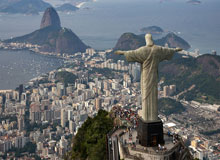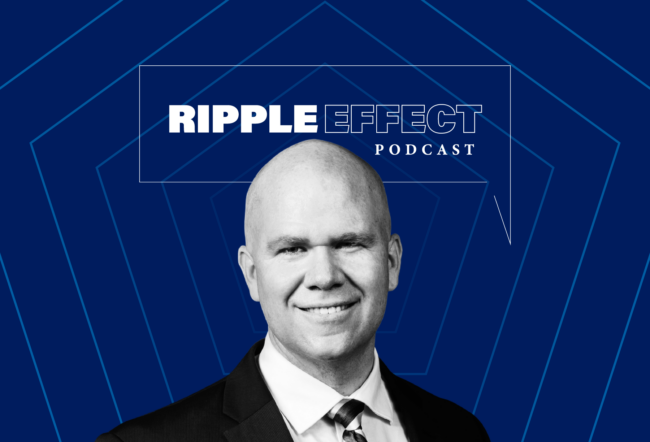Brazil has problems, Guido Mantega, the country's finance minister told the nation's Senate on May 3. There's excess liquidity in the economy, the labor market is tight and inflation is rising. "The good news is that all of these are 'good problems' for us to have. These are the problems of development, and not of stagnation," he stated.
Brazil, like much of the rest of Latin America, is growing. And foreign capital — largely U.S. dollars — is flowing rapidly into the region as a result. Rising oil and other local commodity prices is one reason. Another is the near-zero interest rates outside the region, which are encouraging investing in the higher interest rate markets of Latin America. Then there's the U.S.'s loose monetary policy of pouring greenbacks into emerging market economies.
A snapshot of policy reactions in three countries — Brazil, Colombia and Chile — show a range of strategies, all aimed keeping the dollar stable, protecting local competitiveness and preventing asset bubbles. The global reaction to these measures has been mixed. The International Monetary Fund, for example, recommended in April guidelines and governance structures regarding when nations should deploy capital controls. Big emerging markets, like Brazil, weren't impressed — Mantega, for instance, said Brazil opposed such third-party intrusion on how it manages capital inflows.
'Destabilization Effect'
One big area of focus in Brazil, Chile and Colombia is foreign direct investment (FDI). In all three countries, the main inflow of capital has been in the form of FDI, rather than speculative, or hot, money. While that's a welcome vote of confidence in the sustainability of the countries' economic growth, FDI is also fueling the appreciation of their currencies against the dollar this year. The more dollars coming into the country, the stronger the nations' currencies become.
In Brazil, where its currency, the real,has been appreciating rapidly against the dollar over the past two years to the detriment of the country's exporters, FDI has been growing faster than any other kind of investment. In a report published in early May, Brazil's central bank forecasted that US$55 billion of FDI will enter the country this year, up from US$24.4 billion in 2010. In the first four months of this year, FDI climbed to US$37 billion.
That raises concerns for policy makers, and not just because of the rising real. Alexandre Tombini, head of Brazil's central bank, recently highlighted the "destabilization effect" that rapid FDI inflows can have on the country's banking system. Companies have been piling up on the relatively cheap debt found in the U.S. and Europe, and servicing that debt could come back to haunt them — and local banks — if the dollar strengthens against their home currencies.
Chile has managed the US$8.74 billion of FDI in the country in 2010 with no major tax increases on foreign capital and with its currency down against the dollar 0.47% year-to-date ending May 6.
That's an anomaly, however. The Chilean peso has been appreciating steadily against the dollar since March 15. It traded at a strong 460 pesos to the dollar on April 28, causing jitters throughout the government. By early May, Chile's Minister of Finance Felipe Larrain said the government will not "sit idly" as the peso strengthens.
In the minutes from a recent meeting, the central bank's monetary policy committee concluded that its so-called neutral interest rate policy — ranging between 5.1% and 6.5% under normal global economic conditions — reflected a condition of "internal equilibrium," but could imply "external disequilibrium" due to low interest rates abroad that would find a high-yielding peso more attractive.
Yet, rather than raise taxes on foreign capital coming into the country, as Brazil has done, Chile seemed willing to pause on interest rate hikes and let the currency appreciate at the whims of the market. Chile doesn't have high interest rates per se; but at around 4.25%, the rate is high compared with 1.25% in Europe and next to nothing in the U.S. and Japan. That's attractive to carry-trade — investors from low interest rate countries looking for higher interest rate countries. Between January and May this year, Chile's government bonds have attracted some US$78 million from foreign investors.
The country took it on the chin when its government announced it was buying US$12 billion on January 3 in order to weaken the peso and help Chile's exports compete in world markets. The Chilean peso declinedaround 7% against the dollar during the first few days after the announcement, but eventually began gaining again. "I was afraid at the time that it would lead to a sustained weakening of the peso-dollar rate, but it never did," notes Vlad Signorelli, a global strategist at Bretton Woods Research, an independent financial research firm in the U.S.
Indeed, the Chilean peso now sits where it was in late December, at around 468 pesos to $1. "Authorities might see a 'neutral' interest rate of around 5% and apparently the economic recovery may be sturdy enough to sustain those rates," says Signorelli. He cites industrial production, which registered a "whopping" 30% increase year-over-year in March, the fastest pace in 20 years. "Couple that with the fact that Chile has no capital gains on stock sales and you can see why Chile looks like a very attractive place for portfolio investments and FDI," he adds.
Yet, surprises are likely. Take May 12 for example. Chile raised interest rates by 50 basis points to get ahead of inflation. Current bond prices will drop. New local currency issues will come with higher yield, attracting more foreign money into Chile.
Strong Coffee
Then there's Colombia. As of the end of April, Colombia's inflows amounted to US$96.4 million, even with interest rates below that of Chile's, at 3.75%. Its currency has been appreciating against the dollar this year even faster than several other Latin American currencies, including the Brazilian real. The country is "in the same situation as Brazil" because of high commodity prices and demand for its oil and coffee, according to Wharton management professor Mauro Guillen.
On April 29, as part of new measures to ease the Colombian peso's gains, Finance Minister Juan Carlos Echeverry told reporters that the government will set up an overseas fund with as much as US$1.2 billion from what it has been buying in the local spot market, and will forgo repatriating the fund for the rest of the year. The government is also purchasing a minimum of US$20 million a day until at least June 17. It's the dollar vacuum strategy, sucking up liquidity and keeping it from flowing into the national economy by the way of freer credit, higher production levels and more consumer spending. Echeverry told reporters he "isn't happy" about the peso's strength and he has said on other occasions that Colombia continues to search for other ways to stem gains.
Despite noise about capital controls, the market expectation is that authorities will try to avoid such measures. Echeverry does not seem to be a proponent of capital controls, and despite a strong currency, export revenues continue to grow because of high commodity prices.
What Chile has done with its currency, and with rates to curb inflation, could happen in Colombia, however, experts say. These are tools the three South American countries have used to keep their currencies in check, and inflation in line with Central Bank expectations, as demand for goods and services increases in their home turf. Capital flow from FDI helps push that demand higher.
At the moment at least, Brazil is letting its currency appreciate as a means to fight inflation at home and avoid increasing interest rates or taxes on foreign inflows. Ever since Brazil began raising its financial operations tax, or IOF, on dollar-based credit obtained by local banks through offshore accounts last autumn, the currency strengthened to as much as 1.564 real to $1, the strongest level since June 2008 when the exchange rate hit 1.55 real to $1.
Brazil"is almost being punished for being so attractive to fund managers and corporate investors," Guillen notes. "Its currency gets overvalued and the central bank gets scared and raises interest rates. But that just ends up attracting more investment into fixed income and hurts small and mid-sized companies, which don't have the ability to tap offshore loans like big Brazilian companies can."
As for the big corporate investors, global oil and oil services companies are spending heavily in Brazil's newfound oil wealth off the coast of Rio de Janeiro. Other foreign industry is eyeing Brazil's growing tech-savvy middle class. For example, Foxconn, a Taiwan-based manufacturer of mother boards and video cards, is expected to announce a US$12 billion investment in Jundiaí, São Paulo to build a facility to manufacture components used in Apple iPads and iPhones.
In early October, Brazil's government unveiled plans to raise the IOF tax to 4% from 2%. At the time, foreign investors had bought more than US$5.2 billion of government bonds, double the record-breaking US$2.05 billion purchased in 2009, according to U.S. research house EPFR Global and the Brazilian government. The inflows were causing Brazil's currency to strengthen, and the tax increase was one way the government is attempting to slow the strengthening.
Less than 72 hours later, the real hadn't budged and investors from Japan to London said that the 4% tax was not prohibitive. After all, 11% bond yields from a strong economy and in a stable currency were better than 1% yields from a weak currency in a low-growth economy. So the government increased the tax load further, to 6%, which did help the real weaken for a short while.
The exchange rate went from 1.69 reals to $1 on January 10 to 1.644 reals to $1 just before Carnival celebrations began on March 4. Finance Minister Mantega warned the market then that the government was ready to act. But when the annual holiday season ended, the real declined again.
In late March, Mantega announced a 2% IOF tax for domestic lenders borrowing in dollar accounts offshore. The aim, he said, was to keep dollar debt on the balance sheets of Brazilian banks manageable. At the time, Brazil banks had borrowed 215%in dollars as of mid-March. Brazilian companies, on the other hand, had taken advantage of low U.S. interest rates by increasing dollar borrowing by 60%. As a result, Mantega noted that dollar inflow from offshore credit operations rose 140%, and was not helping the country fight currency appreciation and inflation,, which has been higher than the central bank's 4.5% target for some time.
Shortly afterward, the real strengthened again. Mantega upped the ante and raised the IOF tax to 5.38%, extending the tax to longer loan periods than initially planned. But the weak dollar narrative continued, and with it commodity prices rose, as did the real.
Pressure Points
Brazilian officials appear to have given up trying to control the currency, for now, and are using interest rates along with other measures to fight inflation. According to government estimates, if not for the added taxes on foreign currency transactions, the exchange would be around 1.40 reals to $1.
Although the Brazilian government's plan of action may be unpopular with some who call for even higher interest rates to slash current 6.3% rolling 12-month inflation by 2012, the country's leaders appear willing to bet that when the current monetary easing program in the U.S. ends on June 30, liquidity pressure will ease and that could stop commodities from rising higher in the near term.
The central bank's Tombini told reporters on May 5 that the real's value is growing off the back of economic fundamentals and inflows. "Our interest rates are on a longer-term down trend," he said. "We are actively trying to curb credit expansion and think that credit has grown recently at a safe pace."
But the country's macro-prudential measures to manage credit expansion and control inflation are starting to take shape. The government cut 50 billion reals of public spending. That will have a medium-term affect on government-driven demand for goods and services, and an end to minimum wage hikes above inflation.
The government has also raised banks' deposit rates, so banks have less money to lend. The Finance Ministry expects credit to account for 4.5% of Brazil's GDP in 2011, down from 7.5% in 2010. The demand curve for new credit in the first quarter, and into the second quarter, points lower, according to Mantega's PowerPoint presentation to the Senate in early May.
The country's blend of monetary and fiscal policies has managed inflation better than its peers in the big emerging markets. Inflation swings are less in Brazil than they are in China, India, Russia and Turkey, according to the International Monetary Fund. "Brazil's problems are the best kind of problems. Things really are going Brazil's way," says Guillen.



